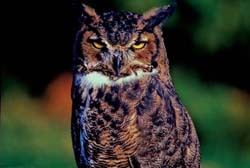 Who's Awake? Me Too!
Who's Awake? Me Too!
Look at the title of this article and read it out loud a couple of times … say it slowly and draw the words out a little. Go ahead … try it!
Congratulations, you have just learned the typical five-noted call of one of the most powerful and dominant raptors of the night sky – the Great Horned Owl.
In owl language, the call sounds something like whooo…whoo-hoo….who..who. Although they do not use nest boxes, during the breeding season, pairs of Great Horned Owls will often perform this call in a duet that starts around dusk and may last for more than an hour. If you are lucky enough to have a pair near your home, you can separate who is who by listening for the female’s higher pitched and slightly faster song.
Odds are good that you do have a pair of these large and long-lived owls living nearby. Able to thrive in virtually any habitat found in the United States, Canada and Mexico, they are equally at home in wilderness or suburban settings. This amazing diversity is the result of their superior physical and behavioral adaptations which enable them to survive under almost any condition.
Superbly adapted for hunting at night with large “night vision” eyes, acute hearing, silent flight and strong talons, it is the rare item of prey that can escape the clutches of a Great Horned Owl. And it’s not picky about what it eats! It has the most varied diet of any North American hawk or owl and has been known to feed on invertebrates, fish, amphibians, reptiles and even other birds. A wide variety of mammals, including skunks and porcupines, makes up the largest portion (up to 90%) of its typical diet.
But life for the Great Horned Owl is not always easy, especially in the early months. Mortality rates during the first year of life can range from 30 to 60 percent depending on local food conditions. But, if a fledging owl can survive to become an adult, it has the longest potential life span of any species of owl in North America. Bird banding studies confirm numerous owls living well into their twenties with the record bird being more than 27 years old.
Great Horned Owls, along with many other species of owls, are regular visitors to backyards all over America. To help you learn more about the ones living close to you, visit us at the store for a wide variety of field guides and other information.
To check the accuracy of your newly-learned imitation of the Great Horned Owl’s call, visit the web site of a Wild Birds Unlimited partner, Cornell Lab of Ornithology, to hear a great audio clip of the call. Remember practice makes perfect!

